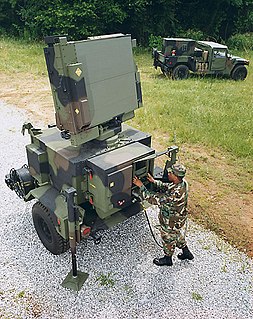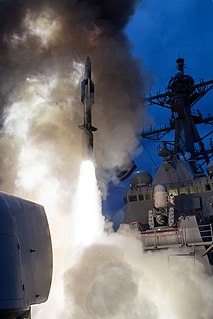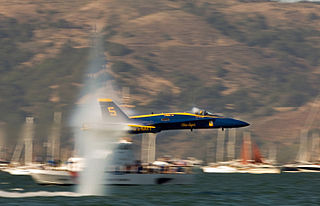
The AIM-120 Advanced Medium-Range Air-to-Air Missile, or AMRAAM, is an American beyond-visual-range air-to-air missile (BVRAAM) capable of all-weather day-and-night operations. Designed with a 7-inch (180mm) diameter form-and-fit factor, and employing active transmit-receive radar guidance instead of semi-active receive-only radar guidance, it has the advantage of being a fire-and-forget weapon when compared to the previous generation Sparrow missiles. When an AMRAAM missile is launched, NATO pilots use the brevity code Fox Three.

The Northrop Grumman E-8 Joint Surveillance Target Attack Radar System is a United States Air Force airborne ground surveillance, battle management and command and control aircraft. It tracks ground vehicles and some aircraft, collects imagery, and relays tactical pictures to ground and air theater commanders. The aircraft is operated by both active duty U.S. Air Force and Air National Guard units and also carries specially trained U.S. Army personnel as additional flight crew.

The Phalanx CIWS is a close-in weapon system for defense against incoming threats such as small boats, surface torpedoes, anti-ship missiles and helicopters. It was designed and manufactured by the General Dynamics Corporation, Pomona Division, later a part of Raytheon. Consisting of a radar-guided 20 mm (0.8 in) Vulcan cannon mounted on a swiveling base, the Phalanx has been used by the United States Navy and the naval forces of 15 other countries. The US Navy deploys it on every class of surface combat ship, except the Zumwalt-class destroyer and San Antonio-class amphibious transport dock. Other users include the British Royal Navy, the Royal Australian Navy, the Royal Canadian Navy and the US Coast Guard.

The Raytheon Company was a major U.S. defense contractor and industrial corporation with core manufacturing concentrations in weapons and military and commercial electronics. It was previously involved in corporate and special-mission aircraft until early 2007. Raytheon was the world's largest producer of guided missiles. In April 2020, the company merged with United Technologies Corporation to form Raytheon Technologies.

The fourth-generation fighter is a class of jet fighters in service from approximately 1980 to the present and represent design concepts of the 1970s. Fourth-generation designs are heavily influenced by lessons learned from the previous generation of combat aircraft. Long-range air-to-air missiles, originally thought to make dogfighting obsolete, proved less influential than expected, precipitating a renewed emphasis on maneuverability. Meanwhile, the growing costs of military aircraft in general and the demonstrated success of aircraft such as the F-4 Phantom II gave rise to the popularity of multirole combat aircraft in parallel with the advances marking the so-called fourth generation.

The Raytheon Sentinel is an airborne battlefield and ground surveillance aircraft formerly operated by the Royal Air Force (RAF). While based on the Bombardier Global Express ultra long-range business jet, the prime contractor for the Sentinel was the American defence firm Raytheon, which supplied most of the mission systems and performed the integration work.

The Defence Research and Development Organisation (DRDO) is the premier agency under the Department of Defence Research and Development in Ministry of Defence of the Government of India, charged with the military's research and development, headquartered in Delhi, India. It was formed in 1958 by the merger of the Technical Development Establishment and the Directorate of Technical Development and Production of the Indian Ordnance Factories with the Defence Science Organisation. Subsequently, Defence Research & Development Service (DRDS) was constituted in 1979 as a service of Group 'A' Officers / Scientists directly under the administrative control of Ministry of Defence.

An active electronically scanned array (AESA) is a type of phased array antenna, which is a computer-controlled array antenna in which the beam of radio waves can be electronically steered to point in different directions without moving the antenna. In the AESA, each antenna element is connected to a small solid-state transmit/receive module (TRM) under the control of a computer, which performs the functions of a transmitter and/or receiver for the antenna. This contrasts with a passive electronically scanned array (PESA), in which all the antenna elements are connected to a single transmitter and/or receiver through phase shifters under the control of the computer. AESA's main use is in radar, and these are known as active phased array radar (APAR).

An electronic countermeasure (ECM) is an electrical or electronic device designed to trick or deceive radar, sonar or other detection systems, like infrared (IR) or lasers. It may be used both offensively and defensively to deny targeting information to an enemy. The system may make many separate targets appear to the enemy, or make the real target appear to disappear or move about randomly. It is used effectively to protect aircraft from guided missiles. Most air forces use ECM to protect their aircraft from attack. It has also been deployed by military ships and recently on some advanced tanks to fool laser/IR guided missiles. It is frequently coupled with stealth advances so that the ECM systems have an easier job. Offensive ECM often takes the form of jamming. Self-protecting (defensive) ECM includes using blip enhancement and jamming of missile terminal homers.

The RIM-162 Evolved SeaSparrow Missile (ESSM) is a development of the RIM-7 Sea Sparrow missile used to protect ships from attacking missiles and aircraft. ESSM is designed to counter supersonic maneuvering anti-ship missiles. ESSM also has the ability to be "quad-packed" in the Mark 41 Vertical Launch System, allowing up to four ESSMs to be carried in a single cell.
A beyond-visual-range missile (BVR) is an air-to-air missile (BVRAAM) that is capable of engaging at ranges of 20 nmi (37 km) or beyond. This range has been achieved using dual pulse rocket motors or booster rocket motor and ramjet sustainer motor.

The AN/MPQ-64 Sentinel is a 3D radar used to alert and cue Short Range Air Defense (SHORAD) weapons to the locations of hostile targets approaching their front line forces. The Sentinel radar is deployed with forward area air defense units of the U.S. Army. It is an X-band range-gated, pulse-Doppler radar system. The antenna uses phase-frequency electronic scanning technology, forming sharp 3D pencil beams covering large surveillance and track volume. The radar automatically acquires, tracks, classifies, identifies and reports targets, including cruise missiles, unmanned aerial vehicles, and both rotary- and fixed-wing aircraft. It uses a high scan rate and operates at a range of 40 km (25 mi). The radar is designed with high resistance to electronic countermeasures (ECM). Mounted on a towed platform, it can be positioned remotely from the rest of the unit, operated autonomously and communicate with the Fire Direction Center (FDC) via wideband fiber-optic link. It can also distribute its data over a SINCGARS radio network.

The ADM-160 MALD is a decoy missile developed by the United States.
The AN/APG-63 and AN/APG-70 are a family of all-weather multimode radar systems designed by Hughes Aircraft for the F-15 Eagle air superiority fighter. These X band pulse-Doppler radar systems are designed for both air-air and air-ground missions; they are able to look up at high-flying targets and down at low-flying targets without being confused by ground clutter. The systems can detect and track aircraft and small high-speed targets at distances beyond visual range down to close range, and at altitudes down to treetop level. The radar feeds target information into the aircraft's central computer for effective weapons delivery. For close-in dogfights, the radar automatically acquires enemy aircraft and projects this information onto the cockpit head-up display. The name is assigned from the Army Navy Joint Electronics Type Designation System.

The RIM-174 Standard Extended Range Active Missile (ERAM), or Standard Missile 6 (SM-6) is a missile in current production for the United States Navy. It was designed for extended range anti-air warfare (ER-AAW) purposes providing capability against fixed and rotary-wing aircraft, unmanned aerial vehicles, anti-ship cruise missiles in flight, both over sea and land, and terminal ballistic missile defense. It can also be used as a high speed anti-ship missile. The missile uses the airframe of the earlier SM-2ER Block IV (RIM-156A) missile, adding the active radar homing seeker from the AIM-120C AMRAAM in place of the semi-active seeker of the previous design. This will improve the capability of the Standard missile against highly agile targets, and targets beyond the effective range of the launching vessels' target illumination radars. Initial operating capability was planned for 2013 and was achieved on 27 November 2013. The SM-6 is not meant to replace the SM-2 series of missiles, but will serve alongside and provide extended range and increased firepower. It was approved for export in January 2017.

Sea skimming is a technique many anti-ship missiles and some fighter or strike aircraft use to avoid radar, infrared detection, and to lower probability of being shot down during their approach to the target.
The AN/APY-10 is an American multifunction radar developed for the U.S. Navy's Boeing P-8 Poseidon maritime patrol and surveillance aircraft. AN/APY-10 is the latest descendant of a radar family originally developed by Texas Instruments, and now Raytheon after it acquired the radar business of TI, for Lockheed P-3 Orion, the predecessor of P-8.

The GBU-39/B Small Diameter Bomb (SDB) is a 250 lb (110 kg) precision-guided glide bomb that is intended to provide aircraft with the ability to carry a higher number of more accurate bombs. Most US Air Force aircraft will be able to carry a pack of four SDBs in place of a single 2,000 lb (907 kg) bomb.

The Joint Land Attack Cruise Missile Defense Elevated Netted Sensor System, or JLENS, was a tethered aerial detection system designed to track boats, ground vehicles, cruise missiles, manned and unmanned aircraft, and other threats. The system had four primary components: two tethered aerostats which utilized a helium/air mix, armored mooring stations, sophisticated radars, and a processing station designed to communicate with anti-missile and other ground and airborne systems. Each system was referred to as an "orbit", and two orbits were built. The Army-led joint program which fielded JLENS was designed to complement fixed-wing surveillance aircraft, saving money on crew, fuel, maintenance and other costs, and give military commanders advance warning to make decisions and provide notifications. Following cost overruns, underperformance, declining support in Congress, and public scrutiny following a snapped tether which allowed one craft moored at Aberdeen Proving Ground, Maryland to drift on a 100-mile uncontrolled descent across Pennsylvania, dragging its cable tether which damaged power lines and cut power to 20,000 homes, the program was suspended in October 2015, and all but discontinued by 2017.

The Raytheon Coyote is a small, expendable, unmanned aircraft system built by the Raytheon Company, with the capability of operating in autonomous swarms. It is launched from a sonobuoy canister with the wings deploying in early flight phase.
















